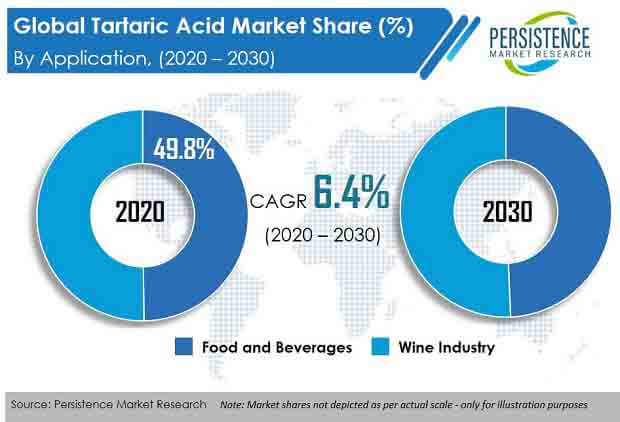Tartaric Acid Market is Segmented by types such as levotartaric acid, dextrotartaric acid, mesotartaric acid and racemic acid having application such as food applications, pharmaceuticals, cosmetics and construction industries.
Industry: Chemicals and Materials
Published Date: September-2020
Format: PPT*, PDF, EXCEL
Delivery Timelines: Contact Sales
Number of Pages: 240
Report ID: PMRREP6811
Tartaric acid is extremely important for the manufacturing of wine, as it helps in controlling their acidity level. Food manufacturers also prefer tartaric acid due to its natural properties, since it is sourced only from grapes or wine residue. Rise in the consumption of wine around the world is a key factor for the expansion of the tartaric acid market size.
Increasing urban population and Western lifestyle across countries such as India and China are other major reasons for the high consumption of wine, which is fueling the growth of the tartaric acid market as well.
Demand for tartaric acid has evolved in the food industry over the past decade, driven by high demand for additives from food manufacturers. Manufacturers in the tartaric acid market space are investing in research & development for sourcing tartaric acid from other sources.
Such investments will boost the growth prospects of the global tartaric acid market through 2030.
The food industry is one of the fastest-growing industries across the globe, which is giving opportunities to new entrants in the market. The tartaric acid market is a consolidated market space, with limited manufacturers and established players focusing on strengthening their production capacities.
Tartaric acid is in great demand from the confectionery industry for the industrial preparation of biscuits and snacks, and as a leavening agent in baking and dessert preparation.
Rapidly growing food & beverage industry across the globe is a major reason for the high demand for tartaric acid at present. Tartaric acid is a versatile ingredient, and is used as an emulsifier, dough conditioner, acidifying agent, and bulking agent.
Tartaric acid is used as an acidifier in many products to regulate their acidity. Bakers use tartaric acid to improve the dough and also increase the shelf life of baked goods. Tartaric acid is also used as a natural preservative in jams & jellies, and also beverages such as carbonated drinks and fruit juices.

Europe holds the largest tartaric acid market share among all regions, owing to the large number of wine producers present in the region. Rising consumption of processed foods and unique beverages, owing to increase in urban population in South Asia, is creating lucrative growth opportunities for new market entrants.
Market players are expanding production capacities to meet the requirements of customers and also adopting acquisition strategies to grow in the market. Many wine makers are focusing on circular economy and establishing their own distilleries to reuse waste obtained from wine making.
Tier-1 players are focusing on strengthening their production facilities by installing advanced equipment to increase production capacity as well as provide high standard products to clients.
The COVID-19 outbreak has affected almost all industries across regions, as most of the manufacturing companies are either closed or are operating with limited production and staff. Despite all this, demand for food remained. High sales of food and beverages was observed, which made manufacturers change their sales methods and shift to online platforms.
However, manufacturers will now have to redefine the supply chain structure. They are changing sourcing patterns and may focus on local providers instead of sourcing from other regions.
The COVID-19 outbreak has slowed down various businesses in most regions. Europe has been highly impacted by coronavirus, which may have a moderate impact on the tartaric acid market.
The global tartaric acid market is expected to witness decent growth during the forecast period of 2020-2030, as South Asia is anticipated to offer growth opportunities for the same period. Rising consumption of wine and processed foods is fueling the global tartaric acid market. Due to the expanding wine industry, the tartaric acid market is estimated to witness 1.5X growth in volume over the forecast period. The market for tartaric acid in wine making applications is expected to reach a total volume of 51KT by the end of 2030.
PMR’s report on the global tartaric acid market offers information divided into three segments - function, application, and region.
| Attribute | Details |
|---|---|
|
Function |
|
|
Application |
|
|
Region |
|
To know more about delivery timeline for this report Contact Sales

The Tartaric Acid Market is projected to register a CAGR of greater than 6.4% during the forecast period (2020-2030).
Anhui hailan bio-technology co., LD, Distillerie Mazzari S.p.A., Industria Chimica Valenzana I.C.V. SpA, AUSTRALIAN TARTARIC PRODUCTS and The Tartaric Chemicals Corporation are the major companies operating in the Tartaric Acid Market.
Asia Pacific is estimated to grow at the highest CAGR over the forecast period (2020-2030).
In 2020, the Asia Pacific accounts for the largest market share in the Tartaric Acid Market.